Scenario Analysis on Energy Consumption and CO2 Emissions Reduction Potential in Building Heating Sector at Community Level
Abstract
1. Introduction
2. Materials and Methods
2.1. Scenario Analysis
2.2. LEAP Model
2.3. DeST Model
2.4. Logistic Model
2.5. ARIMA Model
3. Case Study in Liaobin Coastal Economic Zone
3.1. The Current Situation
3.2. Different Layers of the Model
3.3. Scenario Design
3.3.1. Baseline Scenario
3.3.2. Community Energy Planning Scenario
3.4. Scenario Design of Driving Factors
3.4.1. Socio-Economic Factors
3.4.2. Demographic Factor
3.4.3. Architecture Factor
3.5. Scenario Design of Energy Systems
3.5.1. Baseline Scenario
3.5.2. Community Energy Planning Scenario
3.6. Energy Demand and CO2 Emission Calculation
4. Results and Discussion
4.1. Energy Consumption
4.2. Carbon Dioxide Emission
4.3. Policy Implication
4.3.1. Improve the Policy, Standard and Identification of Energy Conservation and Environmental Protection
4.3.2. Adjust Energy Structure, Use Clean Energy
5. Conclusions
Author Contributions
Acknowledgments
Conflicts of Interest
References
- Li, F.; Zhang, J.D.; Liu, C.Y.; Xiao, M.; Wu, Z. Distribution, bioavailability and probabilistic integrated ecological risk assessment of heavy metals in sediments from Honghu Lake, China. Process Saf. Environ. Prot. 2018, 116, 169–179. [Google Scholar] [CrossRef]
- Li, F.; Zhang, J.D.; Liu, W.; Liu, J.; Huang, J.; Zeng, G. An exploration of an integrated stochastic-fuzzy pollution assessment for heavy metals in urban topsoil based on metal enrichment and bioaccessibility. Sci. Total Environ. 2018, 644, 649–660. [Google Scholar] [CrossRef] [PubMed]
- Guo, J.Y.; Jiang, S.L.; Pang, Y.J. Rice straw biochar modified by aluminum chloride enhances the dewatering of the sludge from municipal sewage treatment plant. Sci. Total Environ. 2019, 654, 338–344. [Google Scholar] [CrossRef] [PubMed]
- Guo, J.Y.; Chen, C.; Jiang, S.L.; Zhou, Y.L. Feasibility and mechanism of combined conditioning with coagulant and flocculant to enhance sludge dewatering. ACS Sustain. Chem. Eng. 2018, 6, 10758–10765. [Google Scholar] [CrossRef]
- Zeng, J.; Liu, Y.; Feiock, R.; Li, F. The impacts of China’s provincial energy policies on major air pollutants: A spatial econometric analysis. Energy Policy 2019, 132, 392–403. [Google Scholar] [CrossRef]
- Solomon, S.; Plattner, G.K.; Knutti, R.; Friedlingstein, P. Irreversible climate change due to carbon dioxide emissions. Proc. Natl. Acad. Sci. USA 2009, 106, 1704–1709. [Google Scholar] [CrossRef] [PubMed]
- Roger, P.J.; Wigley, T.; Green, C. Dangerous assumptions. Nature 2008, 452, 531–532. [Google Scholar]
- Center for Climate and Energy Solutions. Outcomes of the UN Climate Change Conference in Paris. Available online: http://www.c2es.org/docUploads/cop-21-paris-summary-12-2015-final.pdf (accessed on 10 December 2015).
- The Sate Council. The 13th Five-Year Plan of Work on Controlling Greenhouse Gas Emissions. Available online: http://www.gov.cn/zhengce/content/2016-11/04/content_5128619.htm (accessed on 4 November 2016).
- Quadrelli, R.; Peterson, S. The energy-climate challenge: Recent trends in CO2 emissions from fuel combustion. Energy Policy 2007, 35, 5938–5952. [Google Scholar] [CrossRef]
- Koroneos, C.; Zairis, N.; Charaklias, P.; Moussiopoulos, N. Optimization of energy production system in the Dodecanese Islands. Renew. Energy 2005, 30, 195–210. [Google Scholar] [CrossRef]
- Jonathan, R.G.; Koomey, G. Using energy scenarios to explore alternative energy pathways in California. Energy Policy 2005, 33, 1117–1142. [Google Scholar]
- Dagoumas, A.S.; Barker, T.S. Pathways to a low-carbon economy for the UK with the macro-econometric E3MG model. Energy Policy 2010, 38, 3067–3077. [Google Scholar] [CrossRef]
- Toshihiko, N. Energy-economic models and the environment. Prog. Energy Combust. Sci. 2004, 30, 417–475. [Google Scholar]
- Wei, Y.M.; Wu, G.; Liu, L.C.; Fan, Y. Progress in modeling for energy-economy-environment complex system and it’s applications. Chin. J. Manag. 2005, 2, 159–170. [Google Scholar]
- Liu, H.W.; Gallagher, K.S. Catalyzing strategic transformation to a low-carbon economy: ACCS road map for China. Energy Policy 2010, 38, 59–74. [Google Scholar] [CrossRef]
- Limmeechokchai, B.; Chawana, S. Sustainable energy development strategies in the rural Thailand: The case of the improved cooking stove and the small biogas digester. Renew. Sustain. Energy Rev. 2007, 11, 818–837. [Google Scholar] [CrossRef]
- Cai, W.J.; Wang, C.; Chen, J.N.; Wang, K.; Zhang, Y.; Li, X.D. Comparison of CO2 emission scenarios and mitigation opportunities in China’s five sectors in 2020. Energy Policy 2008, 36, 1181–1194. [Google Scholar] [CrossRef]
- Wang, Y.J.; Gu, A.; Zhang, A.L. Recent development of energy supply and demand in China, and energy sector prospects through 2030. Energy Policy 2011, 39, 6745–6759. [Google Scholar] [CrossRef]
- Zhou, N.; Fridley, D.; Khanna, N.Z.; Ke, J.; McNeil, M.; Levine, M. China’s energy and emissions outlook to 2050: Perspectives from bottom-up energy end-use model. Energy Policy 2014, 53, 51–62. [Google Scholar] [CrossRef]
- Kuldna, P.; Peterson, K.; Kuhi-Thalfeldt, R. Knowledge brokering on emissions modelling in Strategic Environmental Assessment of Estonian energy policy with special reference to the LEAP model. Environ. Impact Assess. Rev. 2015, 54, 55–60. [Google Scholar] [CrossRef]
- Vincent, E.N.; Comfort, E.C.; Panchakshara, M.G.; Emodi, A.S.A. Energy policy for low carbon development in Nigeria: A LEAP model application. Renew. Sustain. Energy Rev. 2017, 68 Pt 1, 247–261. [Google Scholar]
- Saba, E.; Muhammad, A.; Asif, K.M.; Ashfaq, B. Modeling and analysis of CPEC energy power projects using LEAP model. In Proceedings of the 2018 International Conference on Computing, Mathematics and Engineering Technologies (iCoMET), Sukkur, Pakistan, 3–4 March 2018. [Google Scholar]
- Lin, J.Y.; Cao, B.; Cui, S.; Wang, W.; Bai, X. Evaluating the effectiveness of urban energy conservation and GHG mitigation measures: The case of Xiamen city, China. Energy Policy 2010, 38, 5123–5132. [Google Scholar] [CrossRef]
- Guo, R.; Cao, X.J.; Yang, X.Y.; Li, Y.; Jiang, D.; Li, F. The strategy of energy-related carbon emission reduction in Shanghai. Energy Policy 2010, 38, 633–638. [Google Scholar]
- Huang, Y.; Jeffrey, B.Y.; Peng, C.Y. The long-term forecast of Taiwan’s energy supply and demand: LEAP model application. Energy Policy 2011, 39, 6790–6803. [Google Scholar] [CrossRef]
- Dhakal, S. Implications of transportation policies on energy and environment in Kathmandu Valley, Nepal. Energy Policy 2003, 31, 1493–1507. [Google Scholar] [CrossRef]
- Ahanchain, M.; Biona, J.B. Monitoring transportation, air pollution and energy demand in the Philippines using leap. In Proceedings of the ASME 2011 International Mechanical Engineering Congress and Exposition, Denver, CO, USA, 11–17 November 2011; Volume 4, p. 361. [Google Scholar]
- Shabbir, R.; Ahmad, S.S. Monitoring urban transport air pollution and energy demand in Rawalpindi and Islamabad using leap model. Energy 2010, 35, 2323–2332. [Google Scholar] [CrossRef]
- Ates, S.A. Energy efficiency and CO2 mitigation potential of the Turkish iron and steel industry using the LEAP (long-range energy alternatives planning) system. Energy 2015, 90, 417–428. [Google Scholar] [CrossRef]
- Malla, S. Household energy consumption patterns and its environmental implications: Assessment of energy access and poverty in Nepal. Energy Policy 2013, 61, 990–1002. [Google Scholar] [CrossRef]
- Xu, G.Y.; Qin, W.F.; Ti, S.G.; Xu, Y.C. Energy and environmental scenario analysis for residential sector based on LEAP. Appl. Mech. Mater. 2011, 130–134, 3133–3138. [Google Scholar] [CrossRef]
- Shin, H.C.; Park, J.W.; Kim, H.S.; Shin, E.S. Environmental and economic assessment of landfill gas electricity generation in Korea using LEAP model. Energy Policy 2005, 33, 1261–1270. [Google Scholar] [CrossRef]
- Zhang, Q.Y.; Tian, W.L.; Wei, Y.M.; Chen, Y.X. External costs from electricity generation of China up to 2030 in energy and abatement scenarios. Energy Policy 2007, 35, 4295–4304. [Google Scholar] [CrossRef]
- Li, D.; Wang, R.S.; Zhou, C.B. LEAP based comprehensive scenario analysis of emergy evaluation on urban residential area. J. Univ. Chin. Acad. Sci. 2009, 26, 72–82. [Google Scholar]
- Bin, C.; Lin, J.L.; Cui, S.H.; Tang, L.N. Scenario analysis of reduction potentials of energy demand and GHG emissions based on LEAP model in Xiamen City. Acta Ecol. 2010, 30, 3358–3367. [Google Scholar]
- Yan, D.; Xie, X.N.; Song, F.T.; Jiang, Y. Building environment design simulation software DeST(1): An overview of developments and information of building simulation and DeST. Heat. Vent. Air Cond. 2004, 34, 48–56. [Google Scholar]
- Wang, J.C.; Guo, Z.G. Logistic Regression Models: Methods and Application; Higher Education Press: Beijing, China, 2001; pp. 145–177. [Google Scholar]
- Tsay, R.S. Analysis of Financial Time Series, 3rd ed.; Wiley: Hoboken, NJ, USA, 2010; pp. 29–107. [Google Scholar]
- MacKay, D. Sustainable Energy—Without Hot Air; UIT Cambridge: Cambridge, UK, 2009; pp. 140–154. [Google Scholar]
- Feng, G.H.; Tian, C.; Liu, J.Y.; Wang, B.L. Energy system planning of commercial and service core area of Liaobin coastal economic zone. Build. Energy Effic. 2014, 42, 27–30. [Google Scholar]
- National Bureau of Statistics. China Energy Statistical Yearbook 2017; China Statistics Press: Beijing, China, 2017; Volume 10, pp. 453–456.
- Eggleston, S.; Buendia, L.; Miwa, K.; Ngara, T.; Tanabe, K. 2006 IPCC Guidelines for National Greenhouse Gas Inventories: Volume 2 Energy; IPCC: Yokohama, Japan, 2006; pp. 104–106. [Google Scholar]
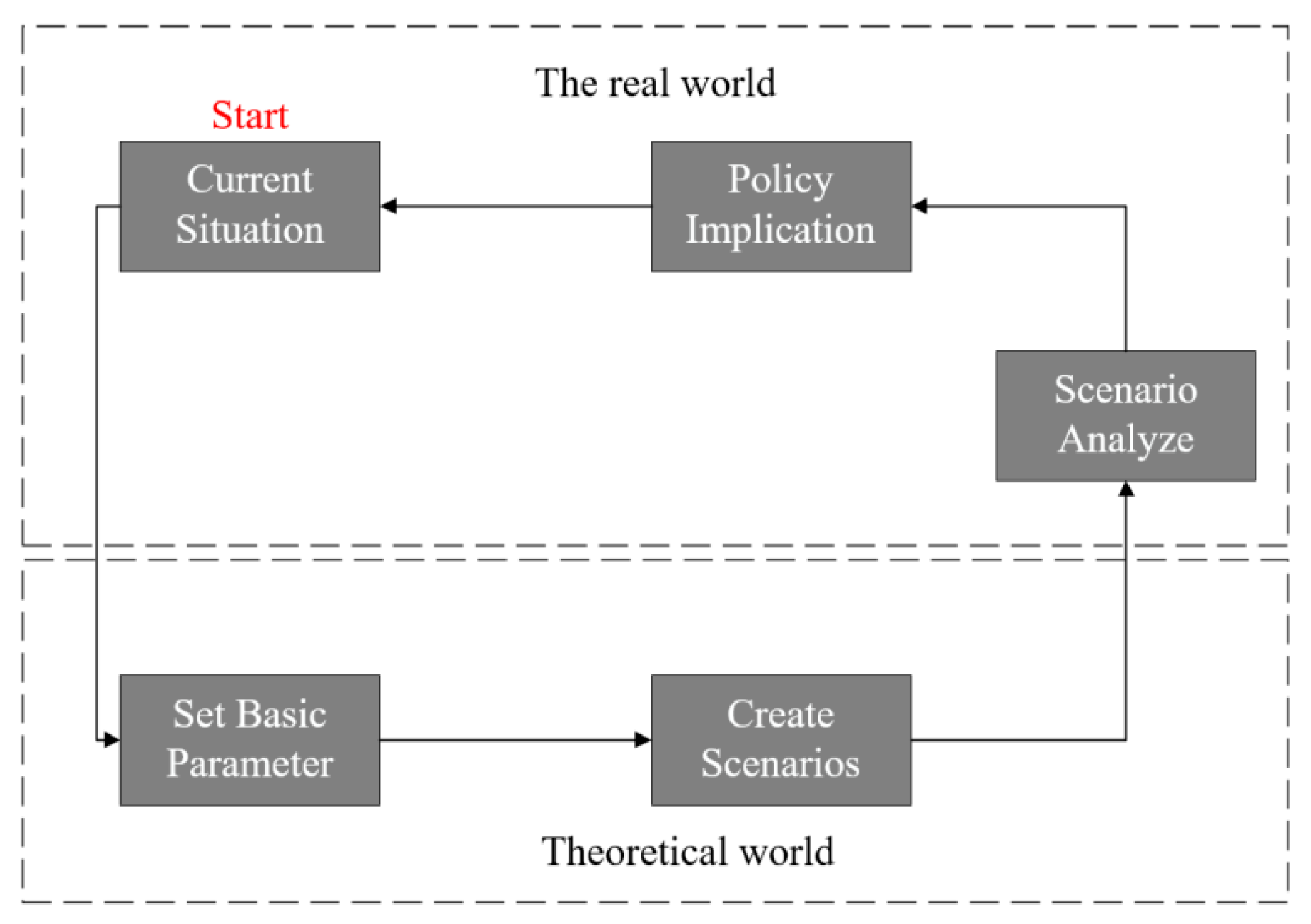
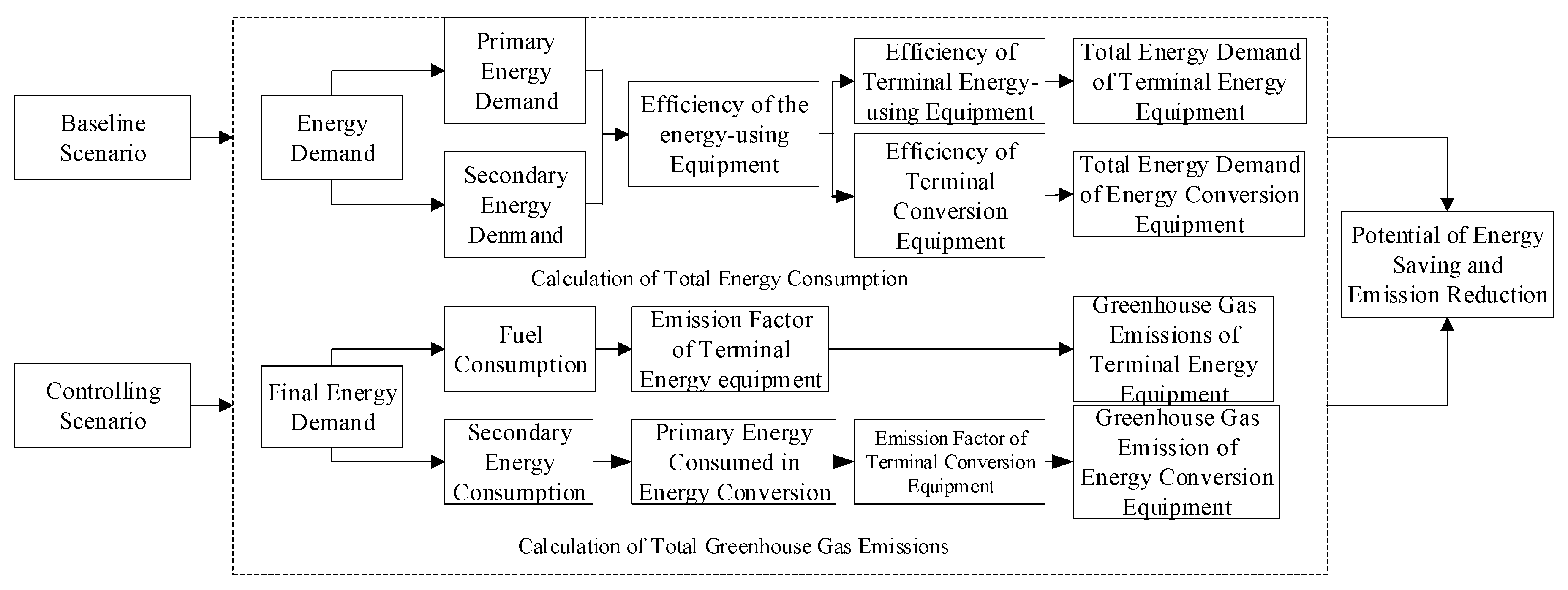
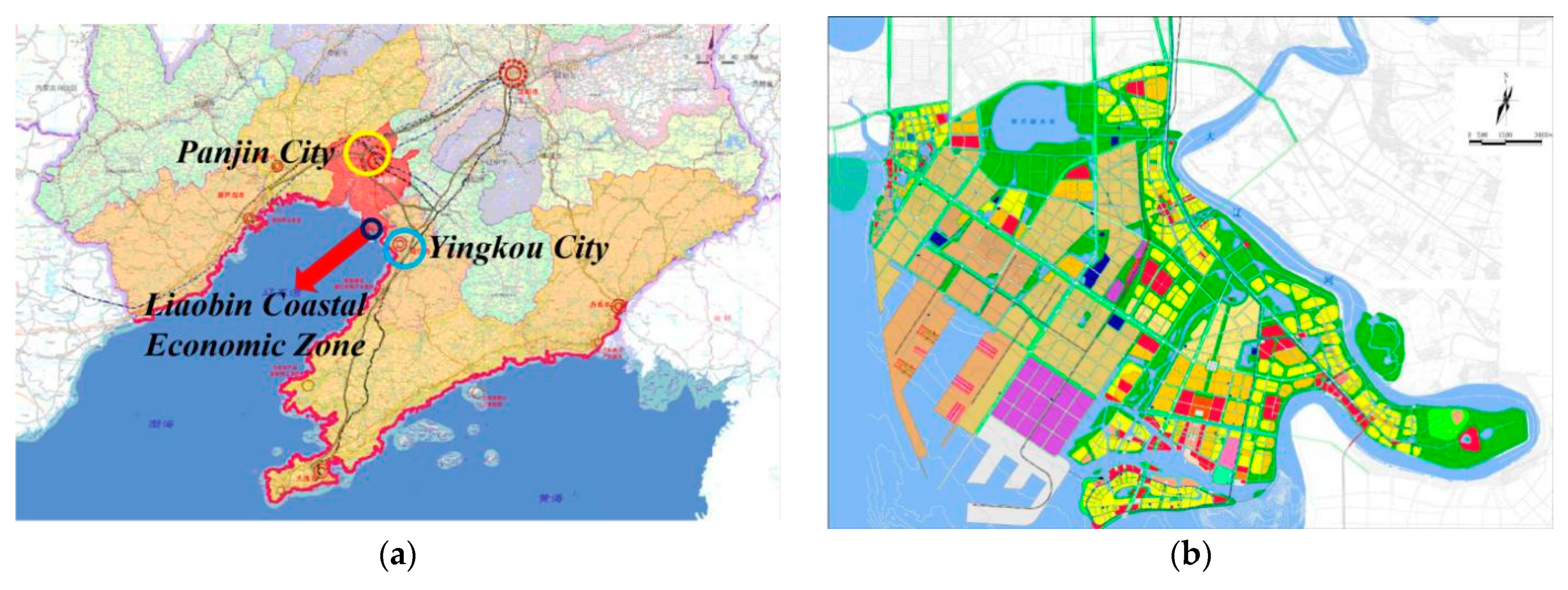
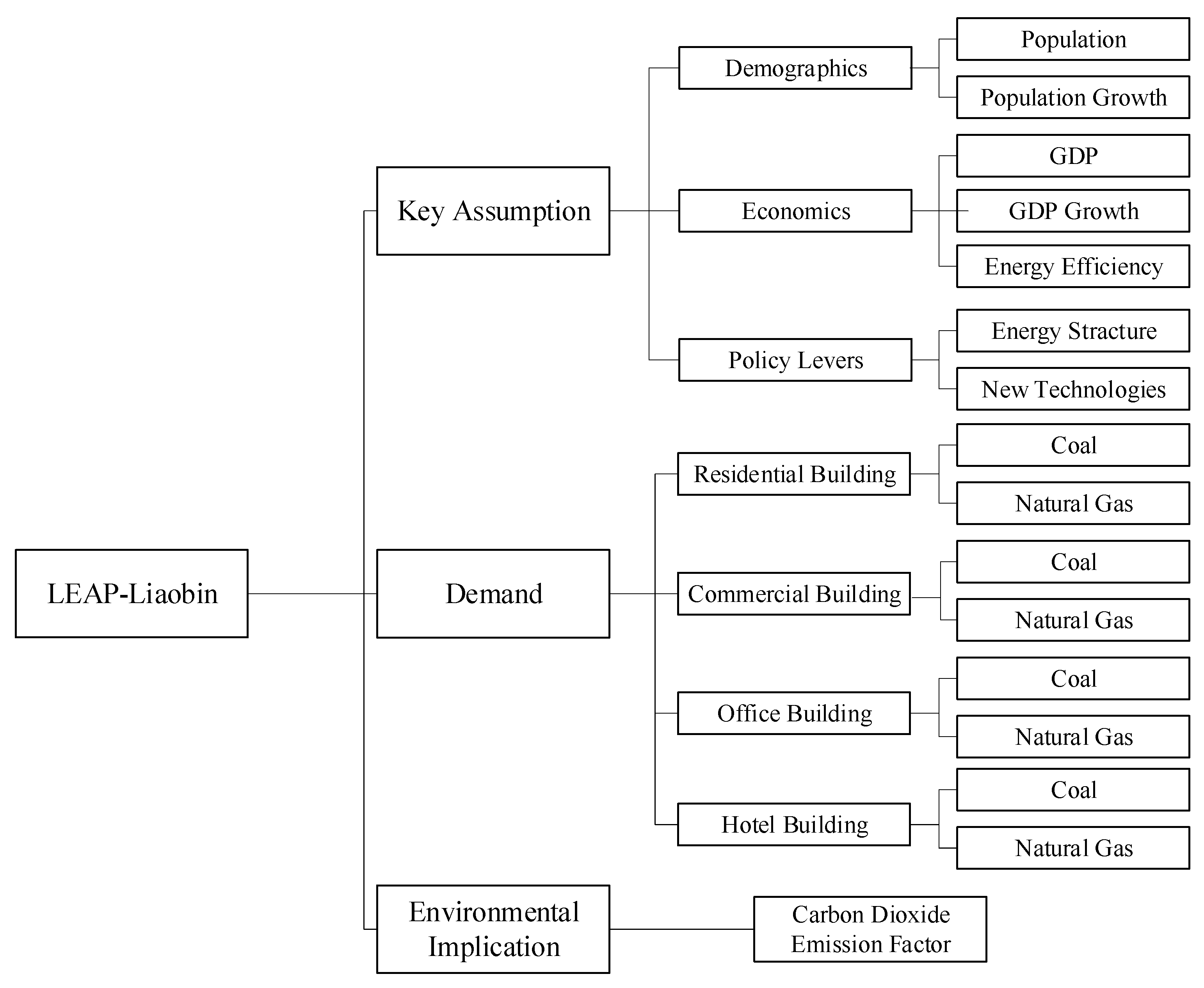

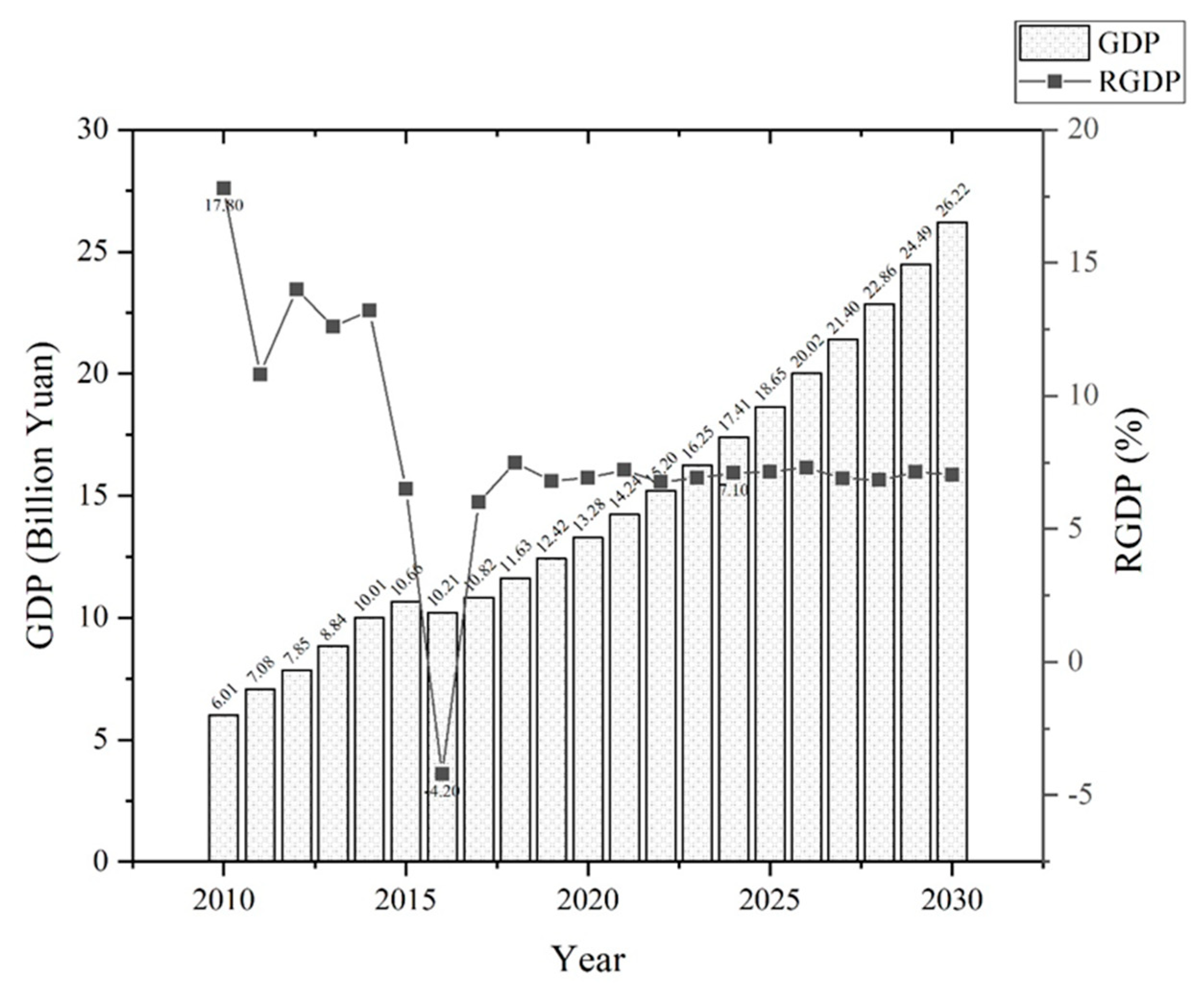

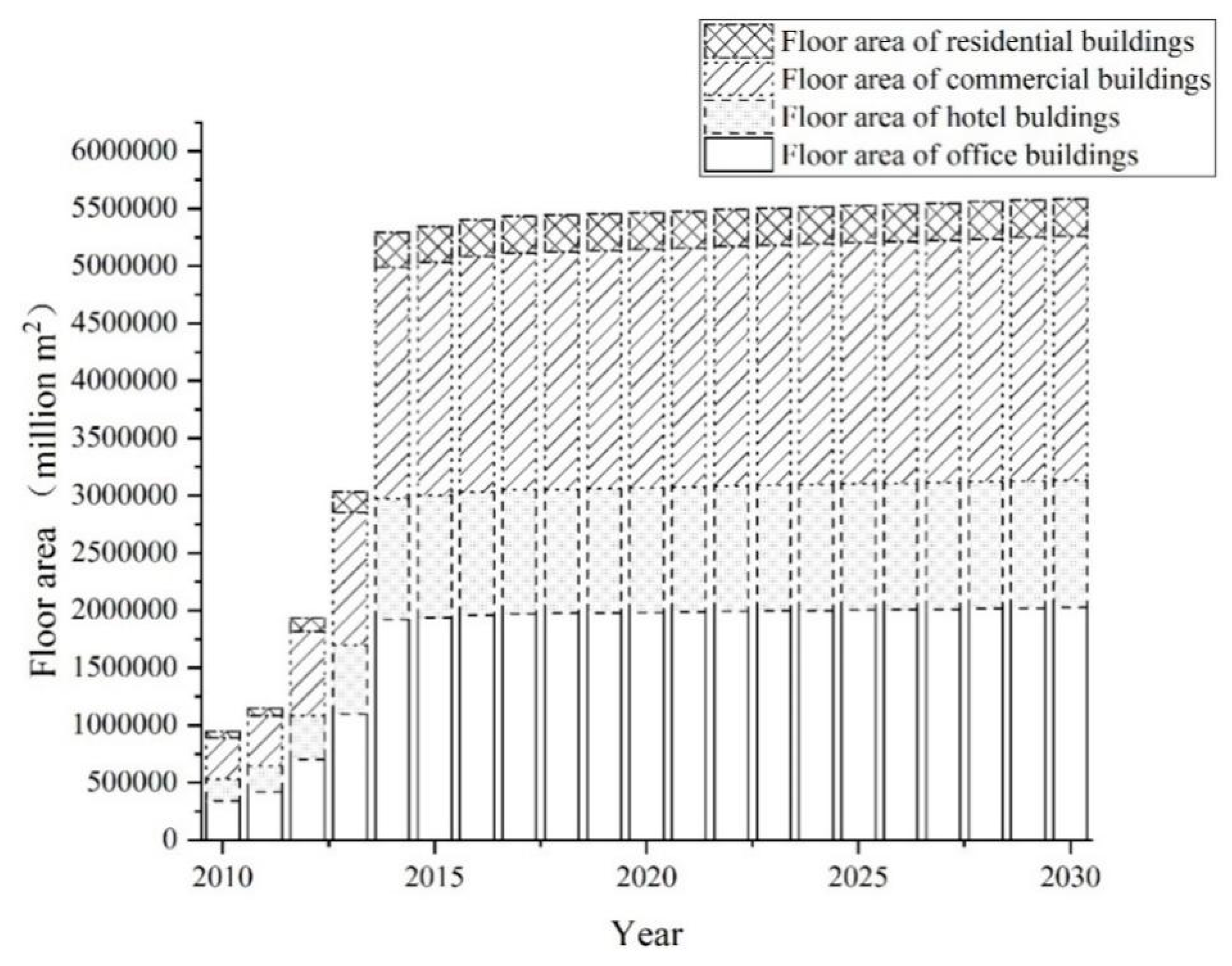
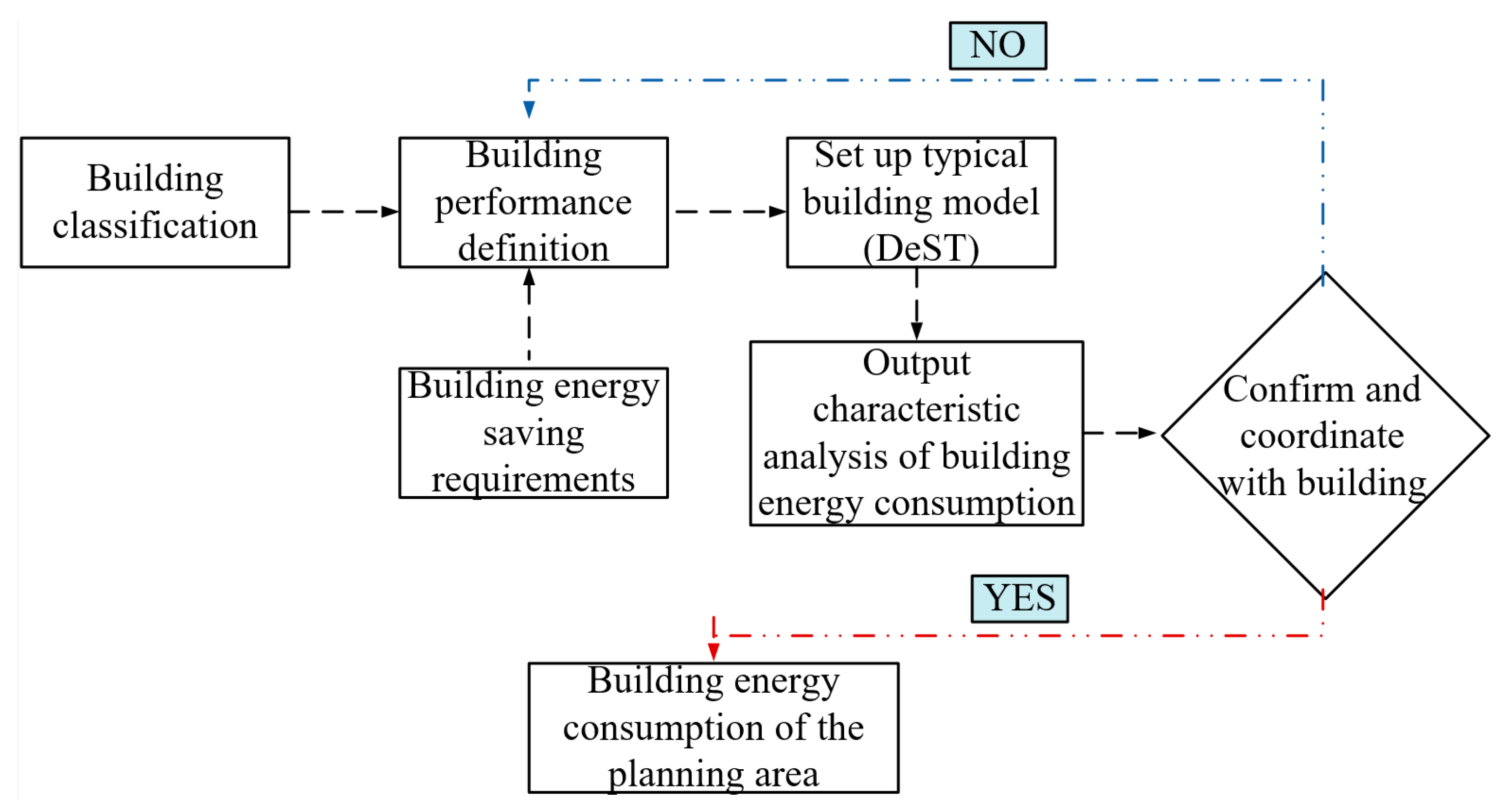
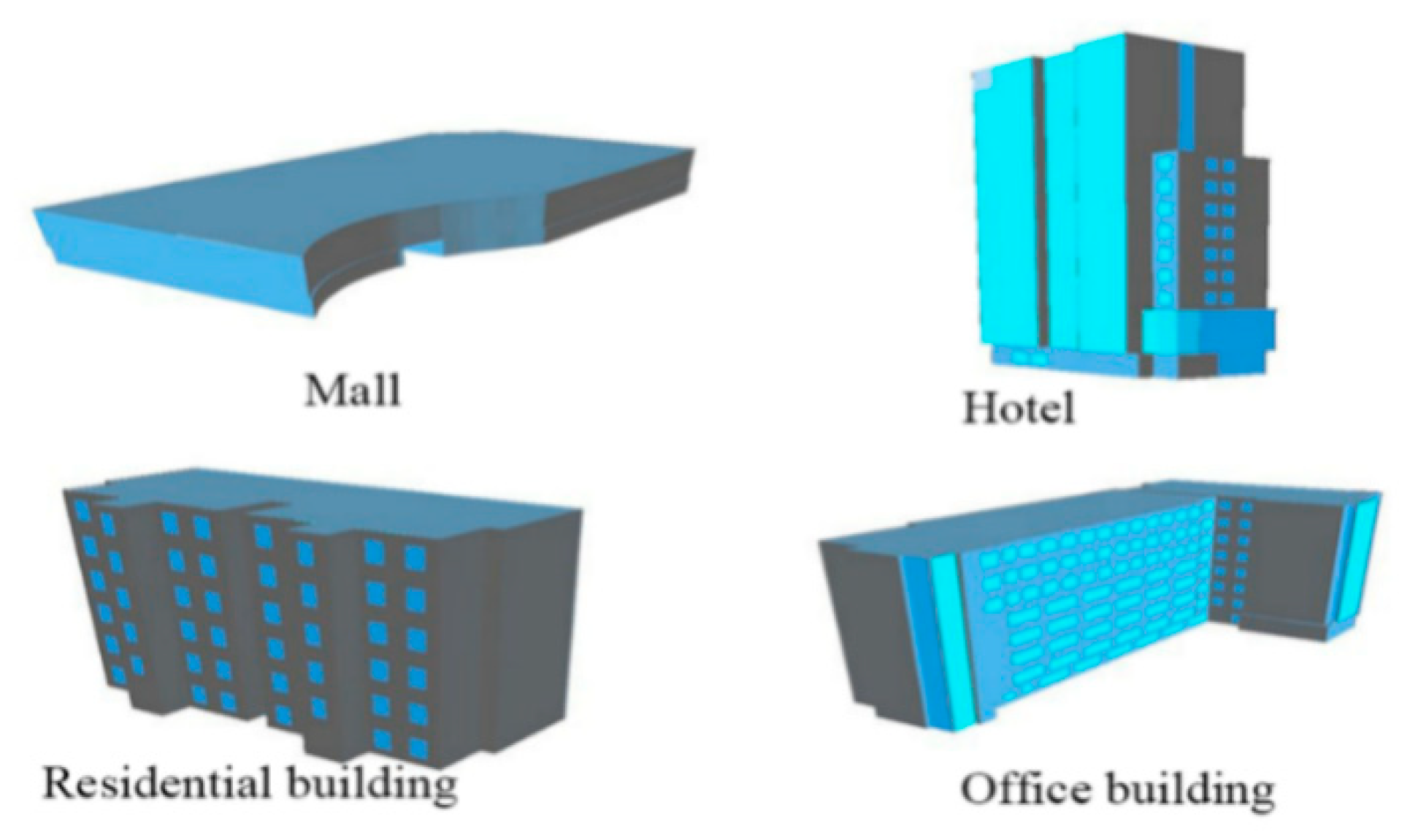

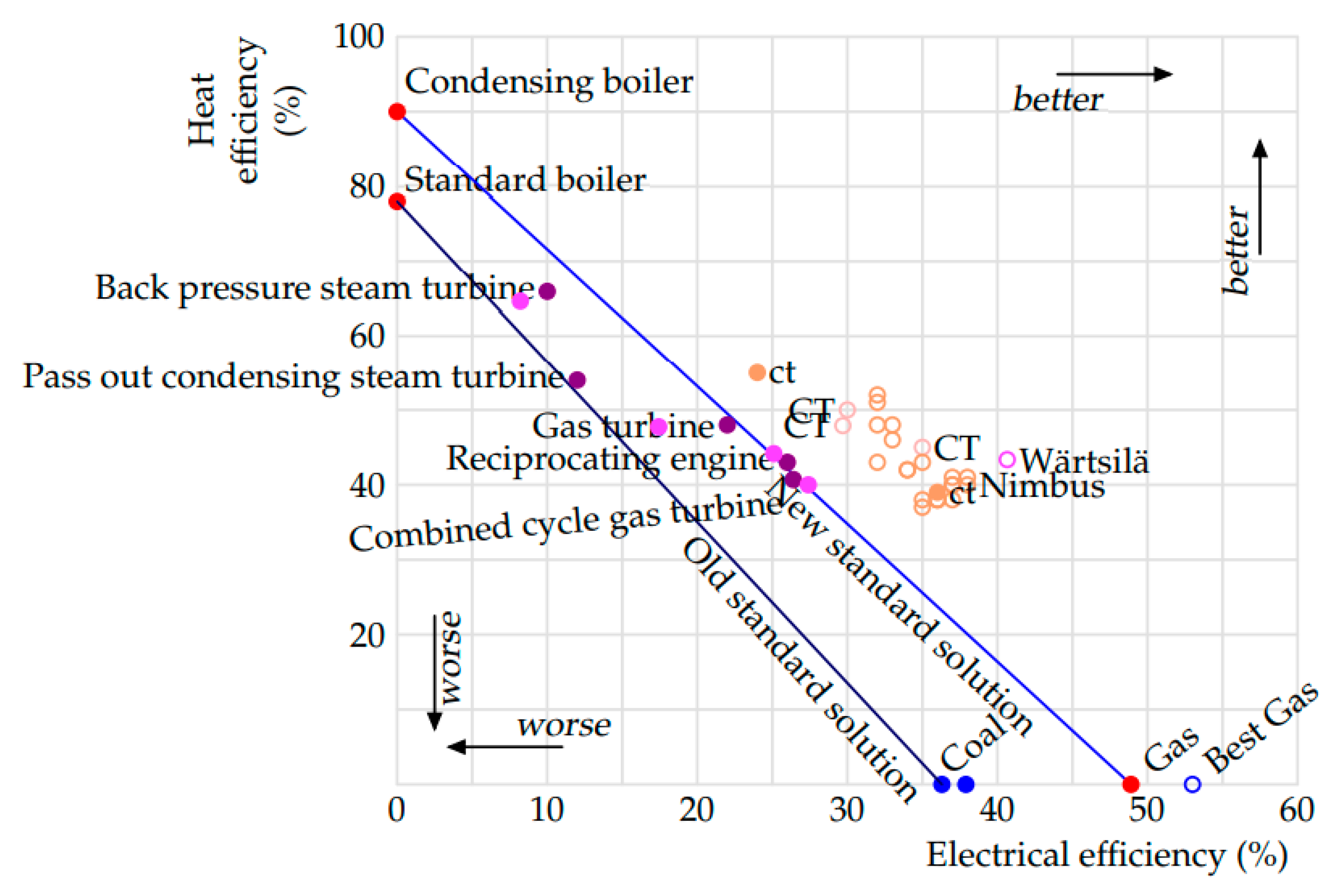



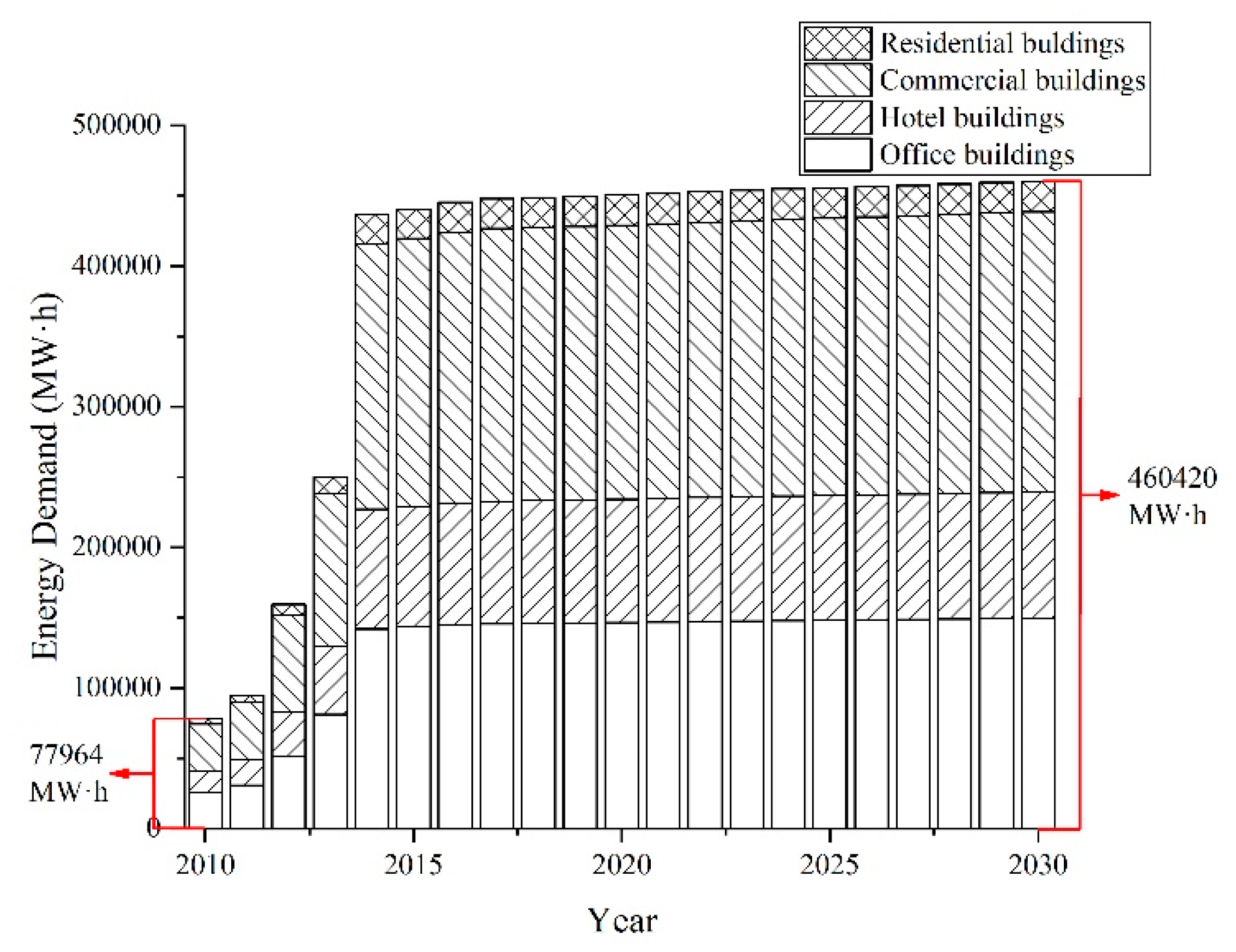
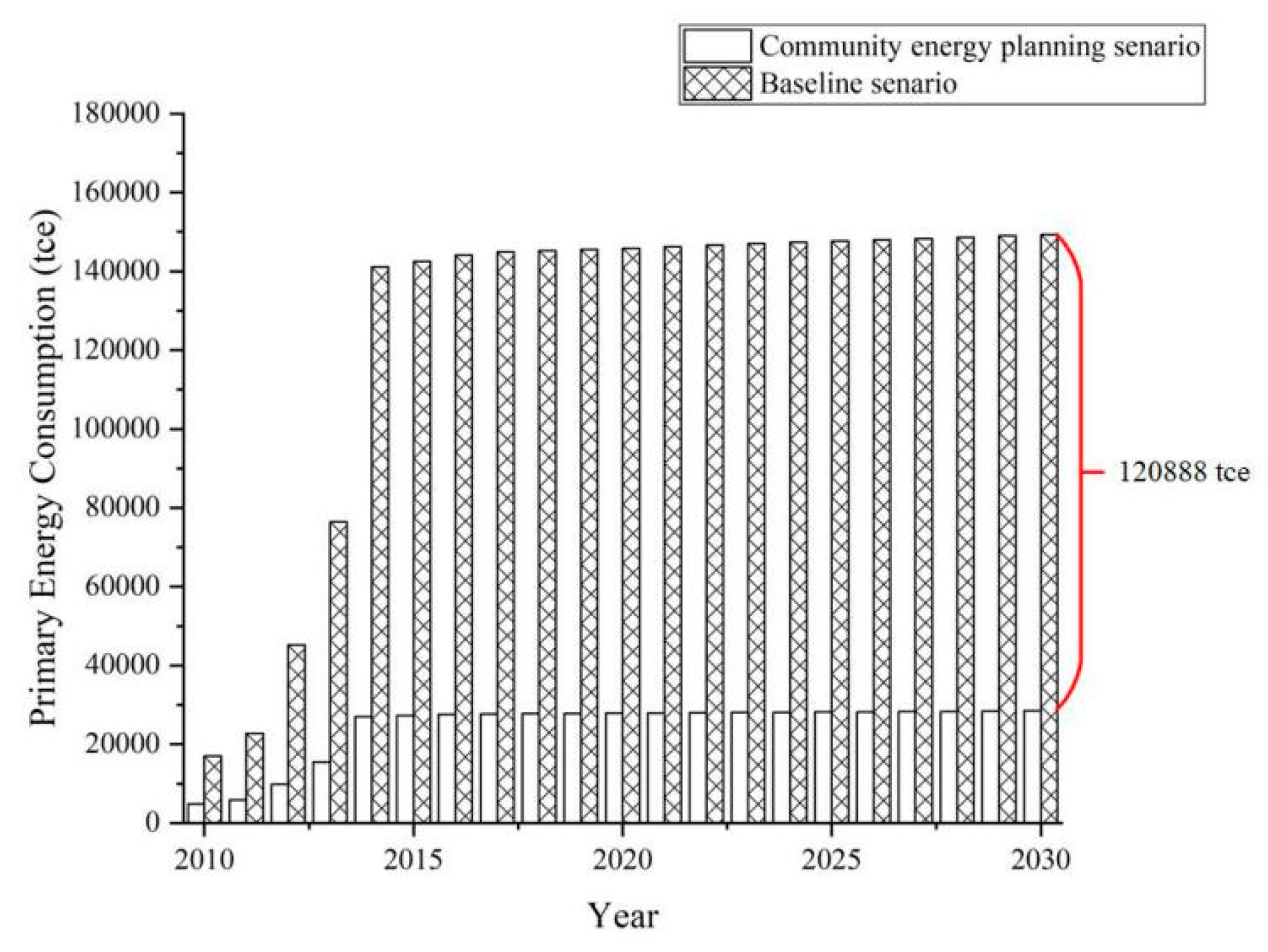

| Methodology | Function | The Advantages and Disadvantages | Typical Models | Research and Development Organization | |
|---|---|---|---|---|---|
| Top-Down Model | Econometrics, General equilibrium theory, Linear programming theory | Energy macroeconomic analysis and energy policy planning | The adoption of economic methods is convenient to provide economic analysis. The technology cannot be described in detail to reflect the feasible technology accepted by the market. A large number of data are used to predict, the potential of technological progress is underestimated, and the influence of technological progress on the economy cannot be controlled. | CGE | Norway |
| 3Es-Model (Macroeconomic, Energy and Environment Sub-model) | NUT (Nagaoka University of Technology)/Japan | ||||
| Marco | IIASA (International Institute for Applied Systems Analysis) | ||||
| GEM-E3 (Groundings Enterprises Markets model-Energy Economic Environment) | NTUA (National Technical University of Athens)/EU | ||||
| Bottom-Up Model | Linear programming theory, Nonlinear programming theory, Multi-objective programming theory, System dynamics approach, Input–output method | Energy technology selection strategy, environmental impact analysis of energy technologies, forecast of energy supply and demand, cost analysis of energy technologies and energy policy analysis | Using the process method, not good at economic analysis, has a detailed description of the technology. Overestimates the potential of technological progress. Using the scattered data to describe the supply technology in detail but emphasizing the change of energy consumption. Directly evaluating the cost of technology selection if the relationship between the energy sector and other sectors is negligible. | MARKAL | ETSAP (Energy Technology Systems Analysis Program)/IEA (International Energy Agency) |
| MESSAGE (Model for Energy Supply Strategy Alternatives and their General Environmental Impact) | IIASA | ||||
| EFOM (Energy Flow Optimization Model) | EU | ||||
| MEDEE (Model Demand Energy Europe) | IEPE (the Institute of Energy Policy and Economic)/France | ||||
| ERIS (Energy Research and Investment Strategy) | PSI (the Paul Scherrer Institute) NTUA and IIASA | ||||
| LEAP | SEI (STOCKHOLM Environment Institute)/Sweden | ||||
| AIM | NIES (National Institute for Environment Studies)/Japan | ||||
| Mixed Energy Model | Linear programming theory, Nonlinear programming theory, Mixed integer programming, Econometrics | Environmental impact analysis of energy technologies, forecast of energy supply and demand, cost analysis of energy technologies and energy policy analysis | The advantages of the above two models are integrated, and the technology selection is fully considered. The cost, again considering the effect of price elasticity, is of the entire energy system. Simulation and analysis. Facilitates more detailed energy economics analysis. The model is complex, and it is a large system that simulates a real energy system. | NEMS (the National Energy Modeling Systems) | EIA (Energy Information Administration)/DOE (Department of Energy) of America |
| IIASA-WECE3 (the IIASA-WECES Energy Economic Environment Model) | IIASA and WEC (World Energy Council) | ||||
| PRIMES (Price Inducing Model of the Energy System) | JOULE/EU | ||||
| POLES (Prospective Outlook on Long-term Energy Systems) | JOULE/EU | ||||
| MIDAS (Multi-national integrated Demand and Supply) | JOULE/EU |
| Policy Driver | Demand Side Driver | Supply Side Driver | |
|---|---|---|---|
| Baseline Scenario | No further policies or measures of energy conservation and emission, the standard of 50% energy saving in the second stage should be strictly implemented in the design of new buildings. | The building load index method (heating index of residential building is 45 W/m2 and heating index of public building is 55 W/m2) is used to calculate heating load, demand-side energy-saving measures are not increased. | Traditional energy sources, such as coal, are used in district heating systems and coal-fired boilers with high thermal efficiency are used, whose thermal efficiency is nearly 85%. |
| Community Energy Planning Scenario | National and local green building standards and building energy efficiency standards revision, increase the stringency of residential building, commercial building and public institution code, strengthen the heating equipment efficiency standards, encourage heat pump installation. | The potential of all local renewable and unused energy is considered. Simplified method of typical building is put forward in building dynamic load forecasting. Energy supply reliability, benefits of energy conservation and emission reduction, and efficiency of energy use are considered. | A clean-type co-generation system that combines the gas internal combustion engine, heat pumps, and absorption heat pumps, whose total efficiency is ~200%. |
| Indicators | Unit | 2030 | |
|---|---|---|---|
| The economic development | GDP | CNY (billion yuan) | 27 |
| Population (New migrants) | People | 62,116 | |
| GDP per unit capita | CNY | 434,670 | |
| Registered urban unemployment rate | % | 0.04 | |
| Disposable income of urban residents | CNY | 80,000 | |
| Research and development funds | CNY (billion yuan) | 8.1 | |
| Research and development funds/GDP | % | 3 | |
| The industry structure | The first industry | CNY (billion yuan) | 5.4 |
| The second industry | CNY (billion yuan) | 129.6 | |
| The third industry | CNY (billion yuan) | 135 | |
| The first industry/GDP | % | 2 | |
| The second industry/GDP | % | 48 | |
| The third industry/GDP | % | 50 | |
| The added value of the third industry per capita | CNY | 150,000 | |
| Open Strategy of leading industry chains | Equipment manufacturing industry | CNY (billion yuan) | 39 |
| Chemical industry | CNY (billion yuan) | 45.4 | |
| Modern service industry | CNY (billion yuan) | 40.5 | |
| New and high technology industry | CNY (billion yuan) | 13 | |
| Logistics industry | CNY (billion yuan) | 32.5 | |
| Modern fishery | CNY (billion yuan) | 5 | |
| Import and export goods trade | CNY (billion yuan) | 75.6 | |
| Import and export services trade | CNY (billion yuan) | 32.4 | |
| Foreign trade dependency | % | 0.4 | |
| Foreign direct investment | USD (billion dollar) | 6.6 | |
| Domestic investment | CNY (billion yuan) | 61.4 | |
| Items | Units | Office Building | Hotel | Mall | Residential Building | |
|---|---|---|---|---|---|---|
| Air conditioning areas | m2 | 12,699.90 | 6995.29 | 13,323.82 | 2038.60 | |
| Load statistics | Annual maximum heating load | kW | 1222.80 | 645.12 | 1631.03 | 205.40 |
| Annual maximum cooling load | kW | 1214.48 | 694.26 | 1765.31 | 97.16 | |
| Annual cumulative heating load | kW·h | 938,268.64 | 565,659.80 | 1,249,286.99 | 137,360.57 | |
| Annual cumulative cooling load | kW·h | 1,021,743.79 | 671,364.13 | 1,081,600.25 | 34,634.00 | |
| Annual cumulative humidifying quantity | kg | 388,661.83 | 290,576.56 | 547,832.02 | 7936.43 | |
| The area of the load indicator | Annual maximum heating load indicator | W/m2 | 96.28 | 92.22 | 122.41 | 100.75 |
| Annual maximum cooling load indicator | W/m2 | 95.63 | 99.25 | 132.49 | 47.66 | |
| Annual cumulative heating indicator | kW·h/m2 | 73.88 | 80.86 | 93.76 | 67.38 | |
| Annual cumulative cooling indicator | kW·h/m2 | 80.45 | 95.97 | 81.18 | 16.99 | |
| Seasonal load indicator | Heating indicator of the heating season | W/m2 | 19.80 | 21.24 | 24.64 | 18.07 |
| Cooling indicator of the air conditioning season | W/m2 | 25.58 | 28.90 | 29.90 | 6.82 | |
| Energy | Average LHV (Lower Heating Value) [42] | Carbon Dioxide Emission Coefficient Based on Energy Value (IPCC 2006) [43] | Carbon Dioxide Emission Coefficient Based on Unit Mass |
|---|---|---|---|
| Raw coal | 20,908 KJ/Kg | 94,600 KgCO2/TJ | 1.978 KgCO2/Kg |
| Natural gas | 38,931 KJ/m3 | 64,200 KgCO2/TJ | 2.499 KgCO2/m3 |
| Year | Energy Demand in Baseline Scenario (MW·h) | Energy Demand in Community Energy Planning Scenario (MW·h) | ||||||
|---|---|---|---|---|---|---|---|---|
| Office Buildings | Hotel Buildings | Commercial Buildings | Residential Buildings | Office Buildings | Hotel Buildings | Commercial Buildings | Residential Buildings | |
| 2010 | 68,353.24 | 37,435.77 | 71,711.97 | 8975.19 | 25,335.83 | 15,186.92 | 33,733.26 | 3708.29 |
| 2011 | 83,096.65 | 45,510.45 | 87,179.83 | 10,911.09 | 30,800.62 | 18,462.65 | 41,009.33 | 4508.15 |
| 2012 | 139,750.50 | 76,538.67 | 146,617.50 | 18,350.07 | 51,799.94 | 31,050.15 | 68,968.77 | 7581.73 |
| 2013 | 219,064.30 | 119,977.30 | 229,828.60 | 28,764.45 | 81,198.42 | 48,672.32 | 108,111.20 | 11,884.65 |
| 2014 | 382,845.70 | 209,677.30 | 401,657.90 | 50,269.93 | 141,905.70 | 85,061.74 | 188,939.60 | 20,770.10 |
| 2015 | 386,276.10 | 211,556.00 | 405,256.80 | 50,720.36 | 143,177.20 | 85,823.91 | 190,632.50 | 20,956.20 |
| 2016 | 390,400.10 | 213,814.70 | 409,583.50 | 51,261.87 | 144,705.80 | 86,740.20 | 192,667.80 | 21,179.94 |
| 2017 | 392,645.70 | 215,044.60 | 411,939.40 | 51,556.73 | 145,538.20 | 87,239.13 | 193,776.00 | 21,301.77 |
| 2018 | 393,391.70 | 215,453.10 | 412,722.10 | 51,654.68 | 145,814.70 | 87,404.88 | 194,144.20 | 21,342.24 |
| 2019 | 394,178.50 | 215,884.10 | 413,547.50 | 51,757.99 | 146,106.30 | 87,579.69 | 194,532.50 | 21,384.92 |
| 2020 | 394,927.50 | 216,294.20 | 414,333.30 | 51,856.33 | 146,383.90 | 87,746.09 | 194,902.10 | 21,425.56 |
| 2021 | 395,835.80 | 216,791.70 | 415,286.30 | 51,975.60 | 146,720.60 | 87,947.91 | 195,350.40 | 21,474.84 |
| 2022 | 397,023.30 | 217,442.10 | 416,532.10 | 52,131.53 | 147,160.80 | 88,211.75 | 195,936.40 | 21,539.26 |
| 2023 | 397,857.00 | 217,898.70 | 417,406.80 | 52,241.01 | 147,469.80 | 88,397.00 | 196,347.90 | 21,584.49 |
| 2024 | 398,811.90 | 218,421.70 | 418,408.60 | 52,366.38 | 147,823.70 | 88,609.15 | 196,819.10 | 21,636.29 |
| 2025 | 399,489.90 | 218,793.00 | 419,119.90 | 52,455.41 | 148,075.00 | 88,759.79 | 197,153.70 | 21,673.08 |
| 2026 | 400,248.90 | 219,208.70 | 419,916.20 | 52,555.07 | 148,356.40 | 88,928.43 | 197,528.30 | 21,714.26 |
| 2027 | 400,969.40 | 219,603.30 | 420,672.10 | 52,649.67 | 148,623.40 | 89,088.50 | 197,883.90 | 21,753.34 |
| 2028 | 401,851.50 | 220,086.40 | 421,597.60 | 52,765.50 | 148,950.40 | 89,284.50 | 198,319.20 | 21,801.20 |
| 2029 | 402,815.90 | 220,614.60 | 422,609.40 | 52,892.14 | 149,307.90 | 89,498.78 | 198,795.20 | 21,853.52 |
| 2030 | 403,661.80 | 221,077.90 | 423,496.90 | 53,003.21 | 149,621.40 | 89,686.73 | 199,212.70 | 21,899.41 |
| Year | 2010 | 2011 | 2012 | 2013 | 2014 | 2015 | 2016 | 2017 | 2018 | 2019 | 2020 |
| Carbon emission of baseline scenario (million kg) | 56.50 | 58.70 | 61.10 | 62.10 | 67.90 | 68.40 | 70.70 | 71.80 | 73.21 | 74.32 | 75.92 |
| Carbon emission of community energy planning scenario (million kg) | 27.06 | 29.75 | 31.45 | 33.17 | 35.20 | 37.34 | 39.40 | 40.17 | 40.96 | 41.76 | 42.58 |
| Year | 2021 | 2022 | 2023 | 2024 | 2025 | 2026 | 2027 | 2028 | 2029 | 2030 | |
| Carbon emission (million kg) | 77.62 | 78.93 | 81.20 | 82.51 | 83.92 | 85.58 | 87.31 | 88.98 | 90.53 | 92.52 | |
| Carbon emission of community energy planning scenario (million kg) | 43.42 | 44.27 | 45.14 | 46.02 | 46.92 | 47.84 | 48.78 | 49.74 | 50.71 | 51.71 |
© 2019 by the authors. Licensee MDPI, Basel, Switzerland. This article is an open access article distributed under the terms and conditions of the Creative Commons Attribution (CC BY) license (http://creativecommons.org/licenses/by/4.0/).
Share and Cite
Tian, C.; Feng, G.; Li, S.; Xu, F. Scenario Analysis on Energy Consumption and CO2 Emissions Reduction Potential in Building Heating Sector at Community Level. Sustainability 2019, 11, 5392. https://doi.org/10.3390/su11195392
Tian C, Feng G, Li S, Xu F. Scenario Analysis on Energy Consumption and CO2 Emissions Reduction Potential in Building Heating Sector at Community Level. Sustainability. 2019; 11(19):5392. https://doi.org/10.3390/su11195392
Chicago/Turabian StyleTian, Chuan, Guohui Feng, Shuai Li, and Fuqiang Xu. 2019. "Scenario Analysis on Energy Consumption and CO2 Emissions Reduction Potential in Building Heating Sector at Community Level" Sustainability 11, no. 19: 5392. https://doi.org/10.3390/su11195392
APA StyleTian, C., Feng, G., Li, S., & Xu, F. (2019). Scenario Analysis on Energy Consumption and CO2 Emissions Reduction Potential in Building Heating Sector at Community Level. Sustainability, 11(19), 5392. https://doi.org/10.3390/su11195392




